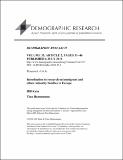Files in this item
Introduction to research on immigrant and ethnic minority families in Europe
Item metadata
| dc.contributor.author | Kulu, Hill | |
| dc.contributor.author | Hannemann, Tina | |
| dc.date.accessioned | 2017-02-13T15:30:15Z | |
| dc.date.available | 2017-02-13T15:30:15Z | |
| dc.date.issued | 2016-07-06 | |
| dc.identifier | 249105668 | |
| dc.identifier | 62b9ac6d-b8eb-492b-a748-59d0ca792ef3 | |
| dc.identifier | 000379346300001 | |
| dc.identifier | 85006856453 | |
| dc.identifier.citation | Kulu , H & Hannemann , T 2016 , ' Introduction to research on immigrant and ethnic minority families in Europe ' , Demographic Research , vol. 35 , 2 , pp. 31-46 . https://doi.org/10.4054/DemRes.2016.35.2 | en |
| dc.identifier.issn | 1435-9871 | |
| dc.identifier.other | ORCID: /0000-0001-8808-0719/work/75997007 | |
| dc.identifier.uri | https://hdl.handle.net/10023/10277 | |
| dc.description.abstract | BACKGROUND This article provides an introduction to the special collection of papers on partnership dynamics among immigrants and their descendants in five selected European countries: Sweden, France, the UK, Spain, and Estonia. RESULTS AND CONCLUSIONS The analysis shows a significant variation in partnership patterns among immigrants in all five countries. Immigrants from countries with more 'conservative' family patterns (e.g., those from Turkey, South Asia, and the Maghreb region) have high marriage rates, low (premarital) cohabitation levels, and are less likely to separate. By contrast, more 'fluid' family formation patterns dominate among some non-European immigrant groups (e.g., Caribbeans, Sub-Saharan Africans, and Latin Americans). The significant diversity of partnership patterns within countries across immigrant groups supports the idea that socialisation factors play an important role in their partnership behaviour. The partnership patterns of immigrants' descendants are 'in-between'. These findings support the idea that both the minority subculture and the mainstream society have an effect on the behaviour of ethnic groups; however, the role of minority subculture seems to be larger than expected among some groups (e.g., individuals of Turkish, South Asian, Slavic, and Maghrebian origin). CONTRIBUTION All five studies report a significant diversity in partnership patterns across ethnic groups and suggest that the diversity in family forms will persist in the future. We argue that future research should investigate family patterns among the 'third generation', examine the links between economic and cultural integration of ethnic minorities, and exploit various novel techniques to analyse the dynamic nature of individuals' lives. | |
| dc.format.extent | 16 | |
| dc.format.extent | 343515 | |
| dc.language.iso | eng | |
| dc.relation.ispartof | Demographic Research | en |
| dc.subject | Labor-market outcomes | en |
| dc.subject | United States | en |
| dc.subject | Partnership dynamics | en |
| dc.subject | West-Germany | en |
| dc.subject | Life-course | en |
| dc.subject | Descendants | en |
| dc.subject | Fertility | en |
| dc.subject | Migration | en |
| dc.subject | Intermarriage | en |
| dc.subject | France | en |
| dc.subject | NDAS | en |
| dc.title | Introduction to research on immigrant and ethnic minority families in Europe | en |
| dc.type | Journal article | en |
| dc.contributor.institution | University of St Andrews. Geography & Sustainable Development | en |
| dc.identifier.doi | https://doi.org/10.4054/DemRes.2016.35.2 | |
| dc.description.status | Peer reviewed | en |
This item appears in the following Collection(s)
Items in the St Andrews Research Repository are protected by copyright, with all rights reserved, unless otherwise indicated.

